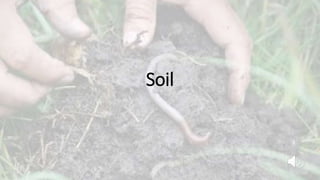
Soil Formation Factors: Climate, Parent Material, Time & More
- 1. Soil
- 2. Soil Formation • Soil is a mixture of rock and mineral particles and organic matter. • Soil is made up of mineral matter that has been broken down by chemical, physical, and biological actions. • There are also living things in soil such as bacteria, fungi, mold, worms, and insects. • The more living things the more productive the soil becomes.
- 3. Facts on Soil - Soil is the #1 supporter for plants - Soil anchors the plant roots so they don’t fall over - Soil is a superstore of nutrients - Moisture for plants is stored in soil.
- 4. Soil Layers • During the process of soil formation, layers develop in the soil. • Most of the volume of soil is formed from the weathered products of a source rock, called the parent material. • A soil whose parent material is the local bedrock is called residual soil. • Transported soil is soil that develops from parent material that has been moved far from its original location, usually by agents of erosion.
- 5. Transported Soil – Removed from its original location Residual Soil – parent material is local bedrock
- 6. Soil Profiles • A soil profile is a vertical sequence of soil layers. • A distinct layer within a soil profile is called a soil horizon. • There are typically four major soil horizons in mature soils: O, A, B, and C.
- 7. • The O-horizon is the top layer of organic material and is composed of humus and leaf litter. • The A-horizon is a layer of weathered rock combined with a rich concentration of dark brown organic material. • The B-horizon, also known as the zone of accumulation, is a red or brown layer enriched over time by clay and minerals deposited by water flowing from above, or percolating upward from below. • The C-horizon contains little or no organic matter and is often made of broken-down bedrock.
- 8. Factors of Soil Formation • Five factors influence soil formation: • Climate • Topography • Parent material • Biological activity • Time.
- 9. Climate Climate is the most significant factor controlling the development of soils because it also affects the weathering of rocks. Temperature, wind, and the amount of rainfall determine the type of soil that can develop. Topography Topography, which includes the slope and orientation of the land, affects the type of soil that forms. Slopes that face south receive more sunlight than other slopes, allowing more vegetation to grow.
- 10. Parent material If the soil is residual, it will have the same chemical composition as the local bedrock. If the soil is transported, the minerals in the soil are likely to be different from those in the local bedrock. Biological activity Organisms including fungi and bacteria, as well as plants and animals, interact with soil. Different types of organisms in a soil can result in different soil orders. Time The effects of time alone can determine the characteristics of a soil. After tens of thousands of years of weathering, most of the original minerals in a soil are changed or washed away.
- 11. Soil Texture and Color For soil, the two main physical properties are color and texture Color The minerals, organic matter, and moisture in each soil horizon determine its color. • The darker the soil, the more nutrients it contains (dark soil contains humus) • Gray soil indicates poor drainage and red soil indicates a lack of nutrients
- 12. Soil Texture The relative proportions of particle sizes determine a soil’s texture, which affects a soil’s capacity to retain moisture and therefore its ability to support plant growth. A soil textural triangle is used to determine a soil’s texture. Knowing the soil’s texture you can find: 1. How easy water flows through it 2.Water holding capacity 3. How well the plant will grow in it
- 13. Soil Permeability and Porosity The particle size that make up each type of soil determines the size of pores between particles. This is known as the soil’s porosity. These the soil hold water and air. The larger the particles making up the soil, larger the pores are between them. Particle size (Largest to Smallest) Sand Silt Clay The soil’s permeability is how easy fluids can flow through its particles.
- 14. • Sand • Feels gritty • Does not stick together in a mass unless wet • Has fewer nutrients for plants than silt and clay • Pores between sand particles allow free drainage of water and entry of air • Holds little water, prone to drought Silt • Feels floury powdery – smooth like putty when wet • Wet silt does not stick together and cannot mold into different shapes • Smaller particles than sand, retains more water for plants • Drains slower than sand • Easily washed away by flowing water
- 15. • Clay • Powdery when dry, sticky/slippery when wet • Wet clay can be molded into any shape • Swells when added to water, shrinks and becomes hard when water evaporates • Pore spaces are very small • Water/air move very slowly through clay • Tremendous ability to hold water
- 16. • Humus • Formed when dead plants and animals decay, which provide essential nutrients for plant growth. • Dark brown or black (color) • Feels crumbly and loose when dry and spongy when wet • When dead plants and animals decay, humus is accumulated in the second layer of soil (A) • Holds more water than sand and silt but not has much as clay. Water will drain quickly.